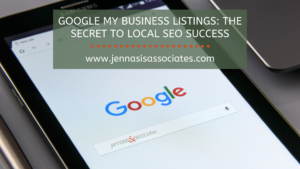Getting noticed at the top of a local search results page is any small business owner’s goal. It makes sense, too, since 90% of people only look at first page results. But making it to the number 1 position in a local search can be difficult if you’re new to Search Engine Optimization (SEO) and don’t have a local marketing strategy in place. Rest assured, there are many local marketing methods and local SEO agencies that can quickly and easily increase your website’s visibility and ranking.
In this guide, we’ll explain what local marketing is, why it’s important for small and midsize businesses, and how a Google My Business listing may be your key to dominating local marketing.
What is Local Marketing?
Local marketing, also known as location-based marketing, is a strategy that targets prospective customers within a specified radius (generally 50 miles) of the physical location of a business.
This strategy is useful for brands that have a physical, brick-and-mortar location—like barber shops, restaurants, and bars—and for service-based companies that travel to a customer’s residence or location, such as landscapers and plumbers.
To draw in customers, local brands can use a combination of outbound and inbound marketing efforts. Below are examples of each:
Outbound—Billboards, radio advertisements, community involvement, etc.
Inbound—Local SEO, Google My Business, content marketing, etc.
You’ve probably heard of the outbound methods before, as well as Google and SEO. But if this is the first time you’ve seen “Local SEO” and “Google My Business,” don’t worry! We’ll explain these terms in-depth and why they’re important later on.
Why is a Local Marketing Strategy Crucial for Local Businesses?
Since most small and midsize businesses rely on foot traffic at their store or location to sell their products or services, it’s essential that potential customers located in their region can easily find them.
And where do most consumers today discover local businesses? If you said online, you’re correct! According to BrightLocal, 93% use the internet to find a local company.
Location is a huge factor for consumers as 93.2% are only willing to travel 20 minutes or less to purchase staples like food, beverages, clothing, etc.
This is great news for local shops and food establishments, especially those that invest in location-based marketing tactics, like local SEO.
What is Local SEO?
At this point you’re probably wondering what local SEO is and how it’s different from SEO?
Great questions. Let’s start by defining just SEO.
Search Engine Optimization (SEO) is the practice of increasing the quality and quantity of traffic to a website through organic (free) search engine results.
All companies can benefit from good search results, but it’s important to know that there is a slight difference between traditional SEO and local SEO.
Regular SEO focuses on improving a website’s visibility on a national or global scale, whereas local SEO encompasses any efforts to improve visibility for local businesses in search results.
Here’s an example of local SEO at work—
Let’s say you’re on vacation and want to go to a seafood restaurant for dinner. Naturally, you’d grab your mobile device and type “seafood restaurants” or “seafood restaurants near me” into your browser.
Once you allow the browser to access your location, you’ll probably see various seafood restaurants in your search results that are located nearby. Chances are, these businesses optimized their websites for local SEO as part of their local marketing strategy.
By implementing local SEO best practices, businesses can connect with local customers in their community to gain valuable foot and website traffic. In fact, 88% of people who do a local search on their mobile device visit or call a store within 24 hours.
So, how can you improve your local SEO and get more visibility? Here’s where a Google My Business listing comes in!
What is a Google My Business Listing?
Google My Business (GMB) is considered the cream of the crop for local search thanks to all of its valuable SEO benefits (which we’ll discuss later on in this blog post).
It’s a free, powerful tool that allows you to manage how your business listing, or Business Profile, appears in Google Search and Google Maps. Google My Business is essentially Google’s way of telling businesses how to be found in their search.
Each business listing contains basic information like the business’s name, address, and category.
Fully optimized listings, however, include additional content—the business’s website, phone number, customer reviews, hours, photos, and more.
GMB profiles help searchers quickly discover, learn about, and engage local businesses in a specific geographic region, all from the search engine results page! The best part is that it’s completely free as long as your business interacts with customers in-person during your listed hours.
So, how do you go about creating a GMB profile and optimizing it?
How to Create & Optimize Your Business Listing for Local Marketing
There are just a handful of steps that you need to take to first create and then optimize your Google My Business profile:
- Log into Google with the email address that you want associated with your business account.
- Create a Business Profile.
- Set up a Google My Business account.
- Claim and verify your business listing.
- Build out your profile.
Once you’ve verified your listing, you can start fleshing out your profile and performing optimization enhancements, such as:
- Uploading a business profile photo
- Adding your phone number, website, and hours
- Choosing primary and secondary business categories
- Selecting the area you serve
- Assigning attributes, i.e. “Cash Only” or “Wheelchair Accessible”
- Publishing Google posts
- Encouraging customers to leave reviews
- Responding to positive (and negative) reviews
Pro-tip: Try to add all of your business information correctly when you initially set up your GMB account. Anyone can click on the “suggest an edit” link on your business page so make sure you list everything accurately and update it frequently.
It can’t be overstated that you should include as much media and details as possible in your GMB listing.
Why, you ask? It all has to do with Google’s algorithm.
How Do Business Listings Improve Local SEO Strategy
Google ranks local results based on relevance, distance, and prominence. It looks specifically for the following ranking signals:
- The location of the searcher
- A Google My Business listing
- Name, address, and phone number (NAP) citations of your business across the web
- Keywords included in a GMB profile
- Overall feeling of online reviews
When you claim and complete your Business Profile, you’re helping Google better understand your business so that it can match your profile against relevant searches that people in your community are doing on a daily basis.
A robust business profile also provides the search engine with strong evidence that your business is legitimate. Google factors customer reviews into its local search ranking because the search engine trusts what others say about your company more than what you say.
Additionally, positive reviews increase your website’s visibility because they boost your social credibility and entice potential customers to click.
Once you build your business listing and Google confirms your company is indeed authentic, you could potentially be rewarded with valuable space in the sidebar of local search, also known as the “Map Pack” or “local, SEO 3-pack.” By getting into the local SEO-3 pack, you have the opportunity to drive more leads to your site and convert more customers!
Partner with a Local SEO Agency
If you want to unlock all of the SEO benefits that Google My Business and other local marketing strategies can have on your company, check out the local SEO services that Jennasis & Associates, a full-service digital marketing agency, has to offer today!





